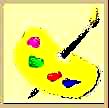
Short Sketch Life of Zainul Abedin
Mymensingh, India -1914.
Graduated from the Government School of Art, Calcutta, 1938
with First position in 1st Class; appointed teacher of the Art School
while still a student there.
Attended the Slade School of Arts, London, United Kingdom, 1951-52.
All India Art Exhibitions at Calcutta, 1938; Exhibition on 1943
Famine, Calcutta, 1944; Exhibition of Muslim Artists, Calcutta, 1946;
Exhibition of Paintings and Brush Drawings at the Imperial Institute,
London, 1951; Exhibition at the Berkley Gallery, London, 1952;
travelling exhibitions in Belgium, Paris, Ankara and Istambul;
Exhibition at Lahore, Pakistan in 1953; Karachi in 1955; Exhibition of
52 works at Smithsonian Institution, Washinton D.C., USA in 1957;
'Life in Bangladesh', a 65 ft scroll exhibited at
"Nabanna" (The Harvest), an exhibition of Artists at Dhaka, 1970;
exhibitions of his works on the Guerrilla War in many arab cities to
encourage the PLO fighters in 1970.
'Governor's Gold Medal' in the All India Art Exhibition -
1938 for a group of water color landscapes, mostly on the river Brahmaputra.
Life Membership of fazlul Huq Hall, Dhaka University in 1958;
"Pride of Performance" the highest award for creative artists by the
President of Pakistan in 1959;
"Hilal-i-Imtiaz", a civilian title by the Pakistan Government in
1959 and, later, denounced the title in 1971;
"Gold Medal" by the then USSR Government in 1961;
Visiting Professor of Fine Arts, Peshwar University, Pakistan;
Judge of the Biennale Exhibition of RCD countries at Tehran, Iran in
1966;
Honorary President of Bangla Academy, 1972-74;
Visiting Professor of Fine Arts, Dhaka University in 1973;
Member of the Congress for World Unity in Philadelphia, USA in 1974;
National Professor of Bangladesh in 1974;
D. Litt by the University of Delhi, India.
First Principal-designate of the Government
Institute at Dhaka, the first art school of Bangladesh in 1948;
Organized the 'Nabanna' Exhibition and displayed a 65 foot long
scroll depicting the story of rural Bangladesh,
through its phases, from abundance to poverty, was contributed at the
'Nabanna' Exhibition in 1970, at the height of non cooperation movement
against Pakistan regime. Nabanna exhibition was symbolic of the
artists' protest and a milestone in demanding cultural and
political freedom.
A 30 ft long scroll, done in blank ink over wax outlines, depicting
the impact of cyclones of 1970;
One of the designer of the pages of the Constitution of Bangladesh;
Founded the Folk Art Museum at Sonargaon, 20 miles southeast of
Dhaka in 1975;
Founded Zainul Abedin Shangrahashala, a gallery of his own works in
Mymensingh in 1975.
Art critic, O. C. Ganguly wrote in 1944 on his Famine
Sketches, " in the daring Bravado of his pitiless strokes there is a
spontaneity, sincerity, and an uncompromising realism which is rare
among modern artists of Bengal. He has, indeed, opened a new page in
modern painting by his distinguished contributions. As truthful records
of the history of Bengal in 1943, Abedin's drawings are invaluable
documents. As a worshipper of beauty in the terrible phase of human life
- le beau dans l'horrible - this artist has raised pictorial art
to dizzy heights from the low level of silly sentimentalism, hitherto
current in Bengal".
Sarojini Naido said, " They are more eloquent in their poignant appeal
than the most eloquent and impassioned words".
Zainul Abedin died in cancer on May 28, in 1976, aged 62. He was buried
in the campus of Dhaka University, beside the Dhaka University mosque,
with access from the Bangladesh College of Arts and Crafts which
he had founded. Rebel poet, Kazi Nazrul Islam is also buried here.